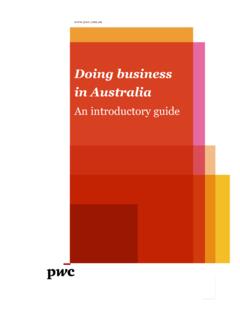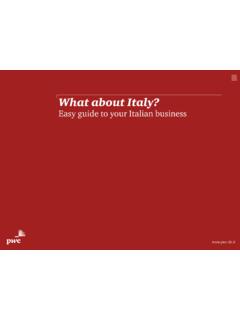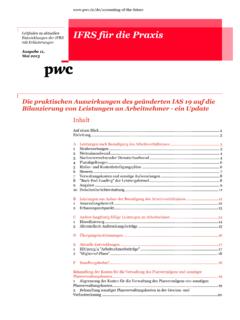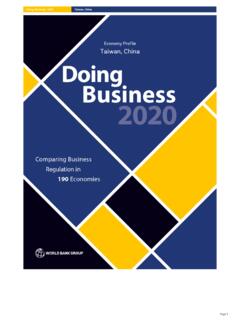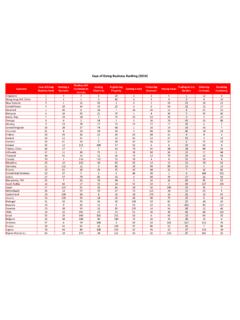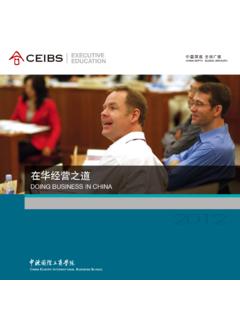Transcription of Doing business in Indonesia - PwC
1 This publication is a joint project withDoing business in IndonesiaExecutive summary 4 Foreword 6 Introduction Doing business in Indonesia 8 Conducting business in Indonesia 12 Taxation in Indonesia 18 Audit and accountancy 26 Human Resources and Employment Law 28 Trade 30 Banking in Indonesia 32 HSBC in Indonesia 34 Country overview 36 Contacts 38 DisclaimerThis document is issued by Hongkong and Shanghai Banking Corporation Limited (the Bank ) in Indonesia in partnership with PricewaterhouseCoopers (PwC). It is not intended as an offer or solicitation for business to anyone in any jurisdiction. It is not intended for distribution to anyone located in or resident in jurisdictions which restrict the distribution of this document. It shall not be copied, reproduced, transmitted or further distributed by any information contained in this document is of a general nature only.
2 It is not meant to be comprehensive and does not constitute financial, legal, tax or other professional advice. You should not act upon the information contained in this publication without obtaining specific professional advice. This document is produced by the Bank together with PricewaterhouseCoopers ( PwC ). Whilst every care has been taken in preparing this document, neither the Bank nor PwC makes any guarantee, representation or warranty (express or implied) as to its accuracy or completeness, and under no circumstances will the Bank or PwC be liable for any loss caused by reliance on any opinion or statement made in this document. Except as specifically indicated, the expressions of opinion are those of the Bank and/or PwC only and are subject to change without notice. This document is not a Financial Promotion . The materials contained in this publication were assembled in August 2012 and were based on the law enforceable and information available at that Issuing the Negative List of Investment in June 2010 to open more business sectors to foreign Amending Tax Laws in 2008 and 2009 to improve tax administration and to reduce the corporate income tax rate to a flat 25% rate starting from Amending laws and regulations in certain sectors such as shipping and mining in order to improve the licensing process and attract more investment in these sectors.
3 5. Developing an integrated service for both, the central and regional governments to simplify the licensing process for businesses operating and investing in Indonesia . Another area of focus for the government is to improve the archipelago s infrastructure. Through the Public Private Partnership (PPP) scheme, the government offers investment opportunities for the infrastructure projects to develop the country s roads, railways, power and utilities. Investments in mining and agriculture sections are also actively encouraged. With a population of almost 240 million of which more than 80% are Moslem, Islamic economics and banking is also a potential growing sector in Indonesia . Currently, establishing an Indonesian limited liability company is the most common form of operating as a foreign investor in Indonesia . Other types of presence, such as representative offices or branches, could be established, but are subject to certain limitations on commercial activities and restrictions for certain sectors.
4 Continued focus on developing the regulatory and tax aspects of operating a business in Indonesia together with the adoption of international accounting and reporting standards should further benefit Indonesia s drive to attract more investment and improve its competitiveness. Executive summary As the fourth most populous country in the world, supported by good political and economic stability, Indonesia s large domestic market offers a wide range of investment opportunities for foreign and domestic investors. With a target economic growth of more than 6% for the coming years, there is a growing emphasis for the government of Indonesia on attracting more foreign investment in order for the overall investment to reach the projected levels of Indonesian Rupiah (IDR) 2,000 trillion, or approximately US$222 billion, by 2014.
5 For the last 10 years the government of Indonesia has been actively introducing measures directed at encouraging investing in Indonesia and improving the country s regulatory and economic environment. Key measures recently introduced can be summarised as follows: 1. Amending the Investment Law in 2007 to provide more assurance on matters such as equal treatment among investors, ability to repatriate profit from Indonesia , investment incentives and protection from nationalisation. 4 Connecting Indonesia to the World In the fast changing and dynamic world that we live in, we have witnessed a re-balancing of the world economies as emerging markets increasingly drive global economic growth. Indonesia is one of the world s leading emerging economies, and the third-fastest growing economy in Asia. It is also the largest economy in Southeast Asia, supported by: GDP of more than US$ 800 billion in 2011, and forecast to grow by in 2012.
6 Strong domestic consumption. Strong trade and investment flows, including intra-regional flows. An Investor-friendly government. An abundance of natural resources. An ample and increasingly talented work force, underpinned by the world s fourth-largest population by operated in Indonesia since 1884, HSBC s knowledge of the dynamics, and resultant opportunities, of the Indonesian markets sets it apart from its competitors. HSBC has the ability to combine both its local presence (with an extensive branch network throughout the country) and global strength to offer the full range of financial services to businesses wishing to tap into this exciting and vibrant hope that you will find this guide book both useful and informative, and look forward to helping your business unlock the tremendous potential of Richards CEO HSBC Indonesia6 Indonesia is the world s largest archipelago and is composed of approximately seventeen thousand islands lying along the equator.
7 These include several large islands which include Java, Sumatera, Kalimantan, Sulawesi and Papua, as well as various islands that are popular tourist destinations, such as Bali, Lombok and is the main and most developed island where almost 60% of the Indonesian population live and most of the business and governmental activities are carried out. With a population of almost 240 million, Indonesia is the fourth most populous country in the world which means it has a large domestic market open for Indonesian Constitution guarantees the right to freedom of religion. However, the government only recognises six official religions, namely Islam ( ), Protestantism ( ), Catholicism (3%), Hinduism ( ), Buddhism and Confucianism ( ).The Indonesian labour force numbers around 113 rapidly rising population is putting strain on the Indonesian employment market, with some 2 million new entrants estimated to be seeking jobs each year.
8 Agriculture and services are the two biggest sectors, employing respectively 43% and 44% of the workforce..IntroductionDoing business in Indonesia8 Economic Structure and Growth The major economic sector in Indonesia is the manufacturing and processing sector which contributes around of the Gross Domestic Product (GDP). Some major industries in this sector are food and beverages, machinery and transportation, chemical and textiles. The manufacturing sector is followed by the agricultural sector, which includes forestry, plantation, farming and fishery, and the trading and hospitality sector. These together contribute around of the G D P. The mining sector, which has been one of the priority sectors, contributes around of the G D P. More than half of this comes from oil and gas mining. Indonesia proved less exposed to the recent global recession than many of its neighbours, largely because exports account for a relatively small proportion of the country s G D P.
9 In 2 0 11 the real GDP grew by , making Indonesia one of the world s best-performing large economies. Growth is expected to be accelerated in 2012 with an estimated growth rate of Exports are also expected to grow, driven largely by healthy demand from China for Indonesia s commodity exports. Physical Infrastructure Infrastructure has been one of the challenges for the Indonesian government in attracting foreign investment in Indonesia . Currently, Indonesia has around 391 thousand kilometers of roads, thousand kilometers of railways, and kilometers of waterways. In addition, Indonesia developed an extensive air transport network that encompasses 652 airports to ensure that all Indonesia s islands are accessible, by either sea or air, although safety remains a key issue. The current infrastructure still needs to be significantly developed to support the targeted economic growth.
10 The priority areas for the government to encourage further investment include the power and energy sectors, water and sanitation facilities, roads, transportation and telecommunications. The Indonesian government is actively promoting a Public Private Partnership (PPP) scheme as an instrument to invite investment in the infrastructure sector. Under the PPP scheme, the government provides a list of potential infrastructure projects around Indonesia to be developed under cooperation with the private sector. Legal Framework Indonesian legislation comes in different forms. The following official hierarchy of Indonesian legislation (from top to bottom) is enumerated under Law No. 10 Year 2004 on the Formulation of Laws and Regulations:1. 1945 Constitution (Undang-Undang Dasar 1945 or UUD 45). 2. Law (Undang-Undang or UU) and Government Regulation in Lieu of Law (Peraturan Pemerintah Pengganti Undang-Undang or Perpu).





